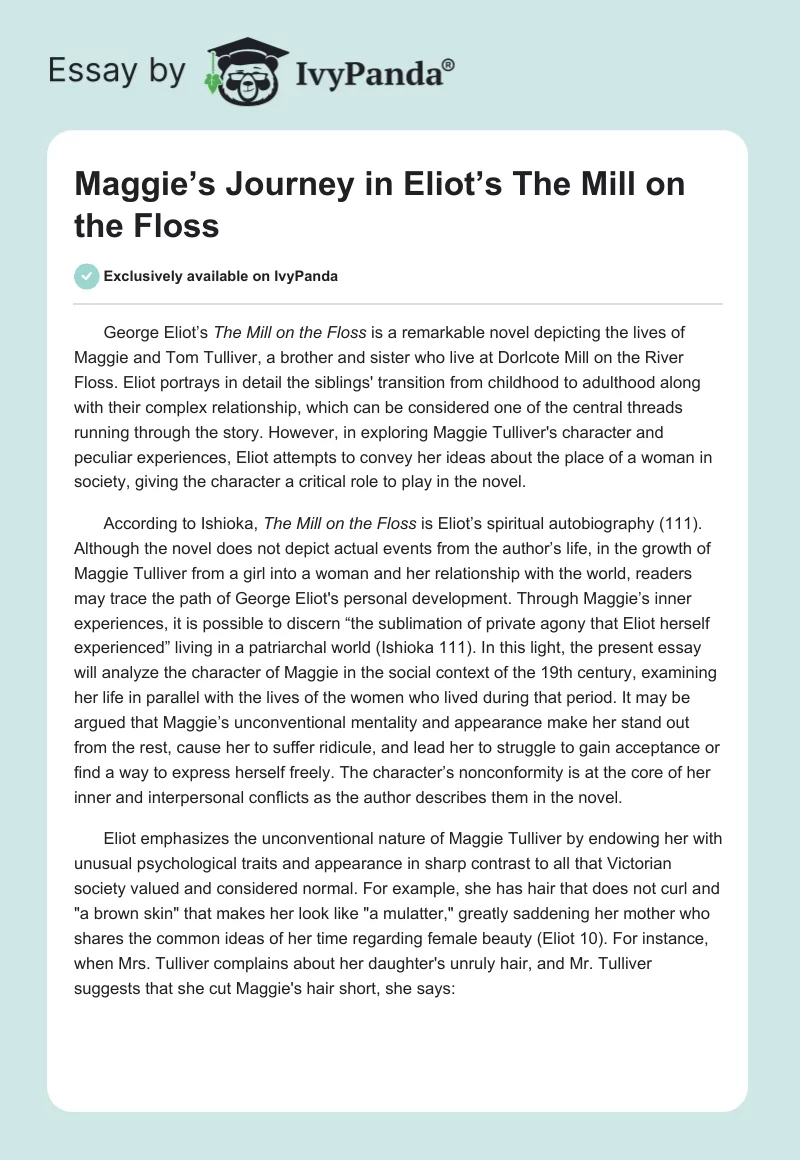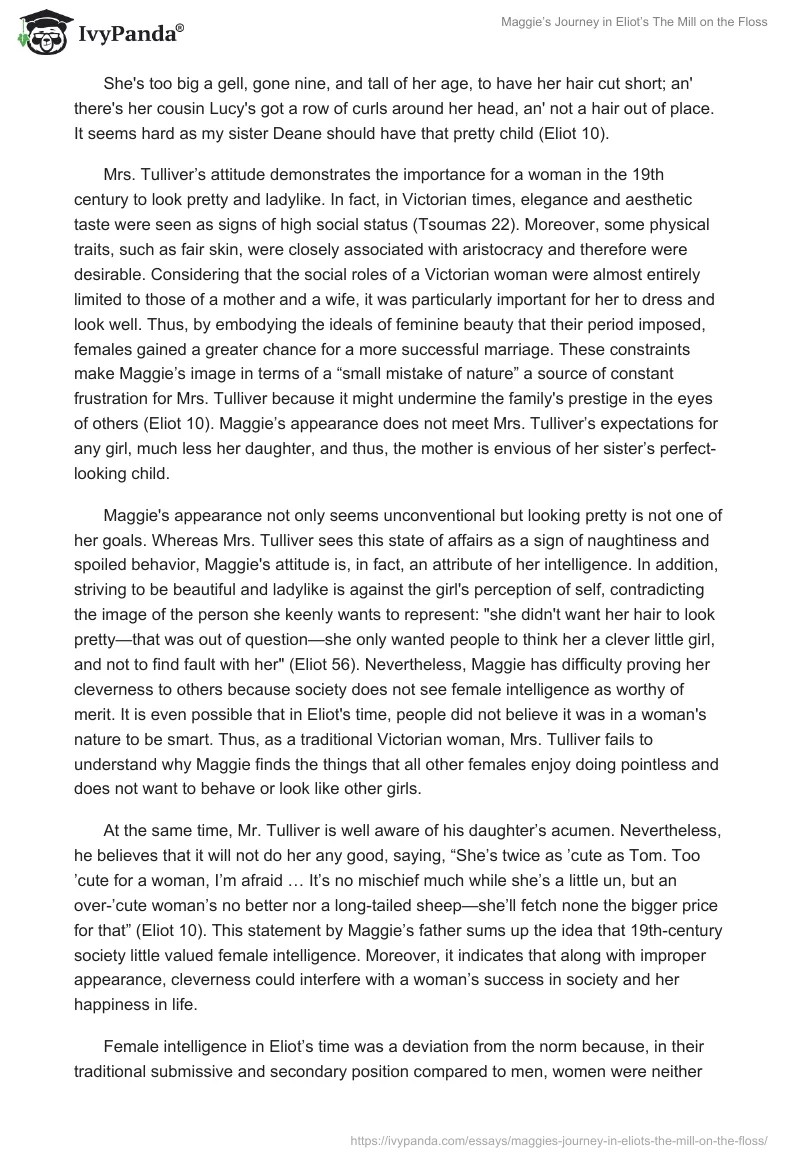George Eliot’s The Mill on the Floss is a remarkable novel depicting the lives of Maggie and Tom Tulliver, a brother and sister who live at Dorlcote Mill on the River Floss. Eliot portrays in detail the siblings’ transition from childhood to adulthood along with their complex relationship, which can be considered one of the central threads running through the story. However, in exploring Maggie Tulliver’s character and peculiar experiences, Eliot attempts to convey her ideas about the place of a woman in society, giving the character a critical role to play in the novel.
According to Ishioka, The Mill on the Floss is Eliot’s spiritual autobiography (111). Although the novel does not depict actual events from the author’s life, in the growth of Maggie Tulliver from a girl into a woman and her relationship with the world, readers may trace the path of George Eliot’s personal development. Through Maggie’s inner experiences, it is possible to discern “the sublimation of private agony that Eliot herself experienced” living in a patriarchal world (Ishioka 111). In this light, the present essay will analyze the character of Maggie in the social context of the 19th century, examining her life in parallel with the lives of the women who lived during that period. It may be argued that Maggie’s unconventional mentality and appearance make her stand out from the rest, cause her to suffer ridicule, and lead her to struggle to gain acceptance or find a way to express herself freely. The character’s nonconformity is at the core of her inner and interpersonal conflicts as the author describes them in the novel.
Eliot emphasizes the unconventional nature of Maggie Tulliver by endowing her with unusual psychological traits and appearance in sharp contrast to all that Victorian society valued and considered normal. For example, she has hair that does not curl and “a brown skin” that makes her look like “a mulatter,” greatly saddening her mother who shares the common ideas of her time regarding female beauty (Eliot 10). For instance, when Mrs. Tulliver complains about her daughter’s unruly hair, and Mr. Tulliver suggests that she cut Maggie’s hair short, she says:
She’s too big a gell, gone nine, and tall of her age, to have her hair cut short; an’ there’s her cousin Lucy’s got a row of curls around her head, an’ not a hair out of place. It seems hard as my sister Deane should have that pretty child (Eliot 10).
Mrs. Tulliver’s attitude demonstrates the importance for a woman in the 19th century to look pretty and ladylike. In fact, in Victorian times, elegance and aesthetic taste were seen as signs of high social status (Tsoumas 22). Moreover, some physical traits, such as fair skin, were closely associated with aristocracy and therefore were desirable. Considering that the social roles of a Victorian woman were almost entirely limited to those of a mother and a wife, it was particularly important for her to dress and look well. Thus, by embodying the ideals of feminine beauty that their period imposed, females gained a greater chance for a more successful marriage. These constraints make Maggie’s image in terms of a “small mistake of nature” a source of constant frustration for Mrs. Tulliver because it might undermine the family’s prestige in the eyes of others (Eliot 10). Maggie’s appearance does not meet Mrs. Tulliver’s expectations for any girl, much less her daughter, and thus, the mother is envious of her sister’s perfect-looking child.
Maggie’s appearance not only seems unconventional but looking pretty is not one of her goals. Whereas Mrs. Tulliver sees this state of affairs as a sign of naughtiness and spoiled behavior, Maggie’s attitude is, in fact, an attribute of her intelligence. In addition, striving to be beautiful and ladylike is against the girl’s perception of self, contradicting the image of the person she keenly wants to represent: “she didn’t want her hair to look pretty—that was out of question—she only wanted people to think her a clever little girl, and not to find fault with her” (Eliot 56). Nevertheless, Maggie has difficulty proving her cleverness to others because society does not see female intelligence as worthy of merit. It is even possible that in Eliot’s time, people did not believe it was in a woman’s nature to be smart. Thus, as a traditional Victorian woman, Mrs. Tulliver fails to understand why Maggie finds the things that all other females enjoy doing pointless and does not want to behave or look like other girls.
At the same time, Mr. Tulliver is well aware of his daughter’s acumen. Nevertheless, he believes that it will not do her any good, saying, “She’s twice as ’cute as Tom. Too ’cute for a woman, I’m afraid … It’s no mischief much while she’s a little un, but an over-’cute woman’s no better nor a long-tailed sheep—she’ll fetch none the bigger price for that” (Eliot 10). This statement by Maggie’s father sums up the idea that 19th-century society little valued female intelligence. Moreover, it indicates that along with improper appearance, cleverness could interfere with a woman’s success in society and her happiness in life.
Female intelligence in Eliot’s time was a deviation from the norm because, in their traditional submissive and secondary position compared to men, women were neither expected to show independence of thought nor produce original ideas. According to Tsoumas, Victorian females “did not need to be educated, nor have knowledge and opinion about anything out of the house” (21). For this reason, Maggie’s natural curiosity and acumen only create hindrances for her. Neither can they find full expression in the setting where she lives nor can they allow her to live happily, easily accepting common values and norms.
Even with such a free spirit as she possesses, Maggie eventually begins to yield to others’ opinions about herself along with overall social conventions. Maggie’s submission to her brother may be viewed as the outward manifestation of her internal identity conflict. Since childhood, she has loved Tom unconditionally and has wanted him to love her in return. However, she has never received the same degree of unconditional affection from her brother. Moreover, as a male brought up in Victorian society, he has always seen his sister as an inferior creature. Thus, his thoughts reflect the idea that “Maggie was a silly little thing; all girls were silly” (Eliot 34). At the same time, “he was very fond of his sister, and meant always to take care of her, make her his housekeeper, and punish her when she did wrong” (Eliot 34). Although Eliot notes that Tom likes Maggie, he has never perceived her as an equal person. His love, in a sense, represents the love of a patriarch and despot. He expects blind obedience from his sister as well as compliance with any wish he might express.
After failing to find independence and to follow her aspirations for knowledge and beauty outside the family, Maggie becomes convinced that she can find a way out through self-renunciation. She begins to deny her desire to please Tom. For example, after Maggie has met Philip in secret, Tom puts forward an ultimatum:
Now, then Maggie, there are two courses for you to take; either you vow solemnly to me, with your hand on my father’s Bible, that you will never have another meeting with Philip Wakem, or you refuse, and I tell my father everything. (Eliot 302)
Maggie eventually succumbs to Tom and, by doing so, acknowledges her weakness and his superiority. When choosing between Tom and Philip, Maggie “rebelled and was humiliated in the same moment” by his consideration that her decisions, search for independence, and romantic relationship without marriage may disgrace the family (Eliot 352). While Maggie understands why he was against her in those moments, she disagrees deep inside with his judgment about her since, like many others, Tom cannot see the true reasons behind her actions.
Maggie’s position in her relationship with Tom is similar to that of many 19th century women. For example, by showing disobedience toward social norms and living by her values, George Eliot herself had several conflicts with the male members of her family. As Ishioka notes, when the writer abandoned her Christian faith and stopped going to church, her father condemned her (111). In addition, when Eliot met George Henry Lewes and decided to live together with him, her brother “disowned her because of her unorthodox union with Lewes” (Ishioka 111). Hence, it seems that the real experiences of the writer have been translated into the fictional experiences of Maggie Tulliver.
The character’s story demonstrates the entire complexity of females’ unfortunate situation in a patriarchal society. According to Yadav and Yadav, this society “implants in women’s mind that they are a liability, so they should live within the boundary of social convention” (50). To a substantial extent, this sense of liability to her family—father and brother, in particular—makes Maggie extremely vulnerable and insecure about her own choices. Although she attempts to escape the boundaries of conservatism, she is ultimately unable to break the social confines because lack of support leads to the rapid depletion of the inner resources she needs to realize her true self.
As the analysis demonstrates, Maggie Tulliver is a complex character who combines a plethora of traits proving the falseness of Victorian stereotypes about women. She grows from a rebellious child into an intelligent and sincere woman who craves knowledge and desires to build her life without following a conventional social pattern or falling into a routine. Nevertheless, she tragically fails to find her place in a world unwilling to accept her as she is. Thus, Maggie’s sense of responsibility for her family becomes her major weakness and is either unknowingly or purposefully used against her by her relatives. Since in the environment where Maggie lives, the sense of liability to family and freedom to follow one’s feelings and passions are incompatible, this unfortunate woman is in constant conflict with herself and the many other characters who follow the social conventions of their time: her mother, Tom, and others. In this way, through the portrayal of Maggie, Eliot demonstrates the severity of limitations imposed on women in 19th-century society.
Works Cited
Eliot, George. The Mill on the Floss. Wordsworth Classics, 1999.
Ishioka, Mari. Conflicts Between Duty and Love in Maggie Tulliver. www.soka.ac.jp/files/ja/20170429_203010.pdf. Accessed 7 May 2019.
Tsoumas, Johannis. “Beauty and Morality as Female Values in the Victorian Middle Class Interior Decoration (1837-1901).” Revista Interdisciplinar Internacional de Artes Visuais, vol. 3, no. 2, 2016, pp.19-31.
Yadav, Sanju, and Anju Yadav. “George Eliot’s The Mill on the Floss: An Approach to Feminism.” International Journal of English and Literature, vol. 6, no. 4, 2016, pp. 45-54.


